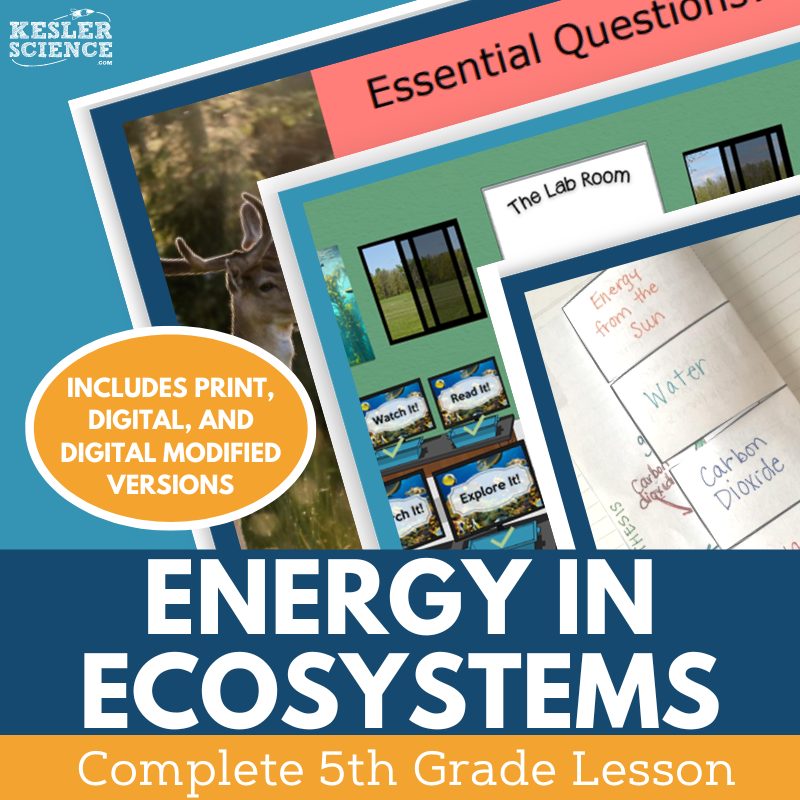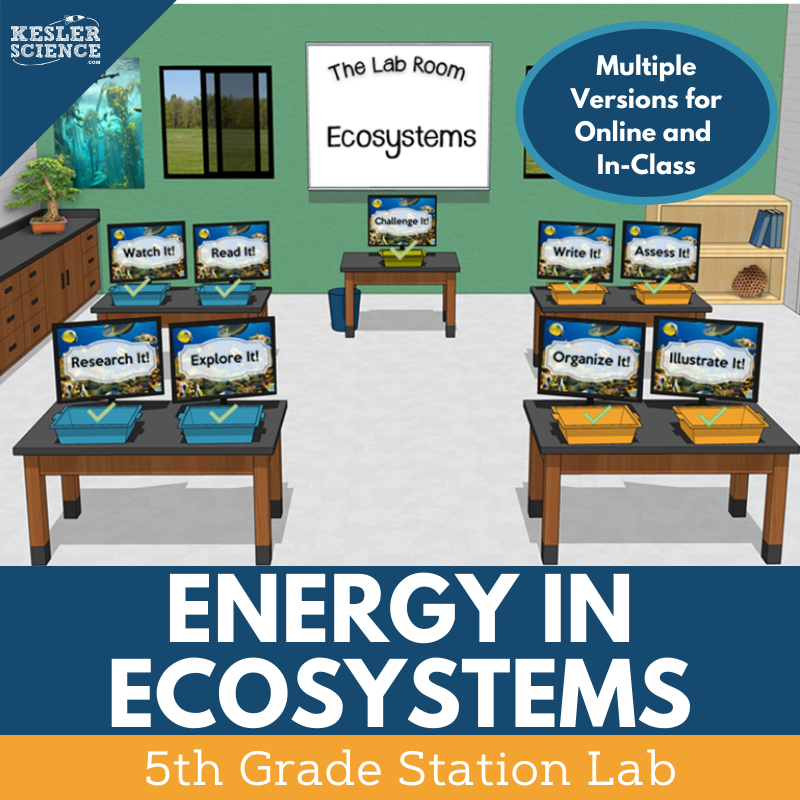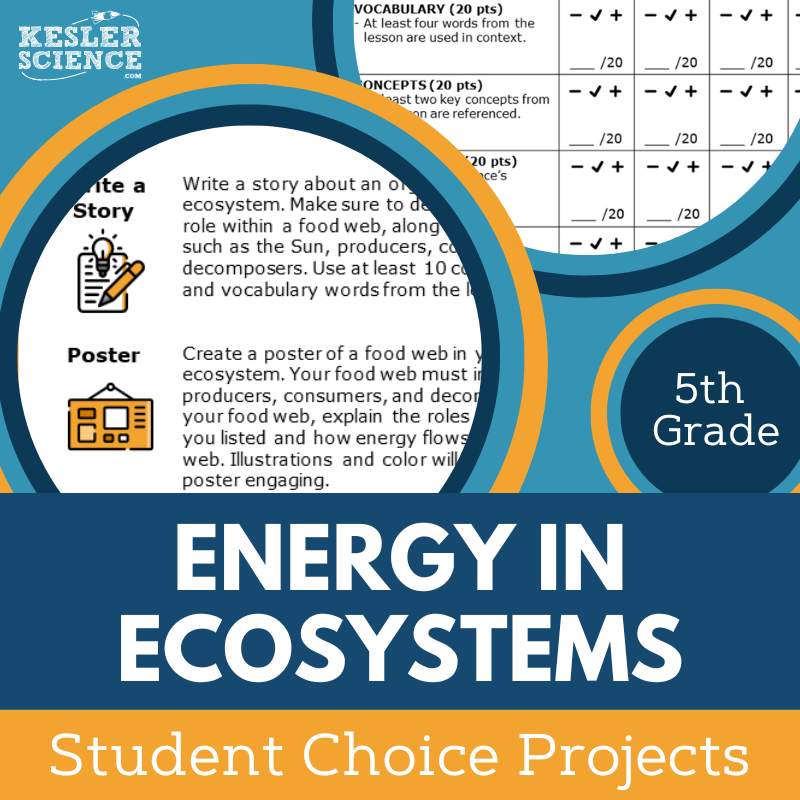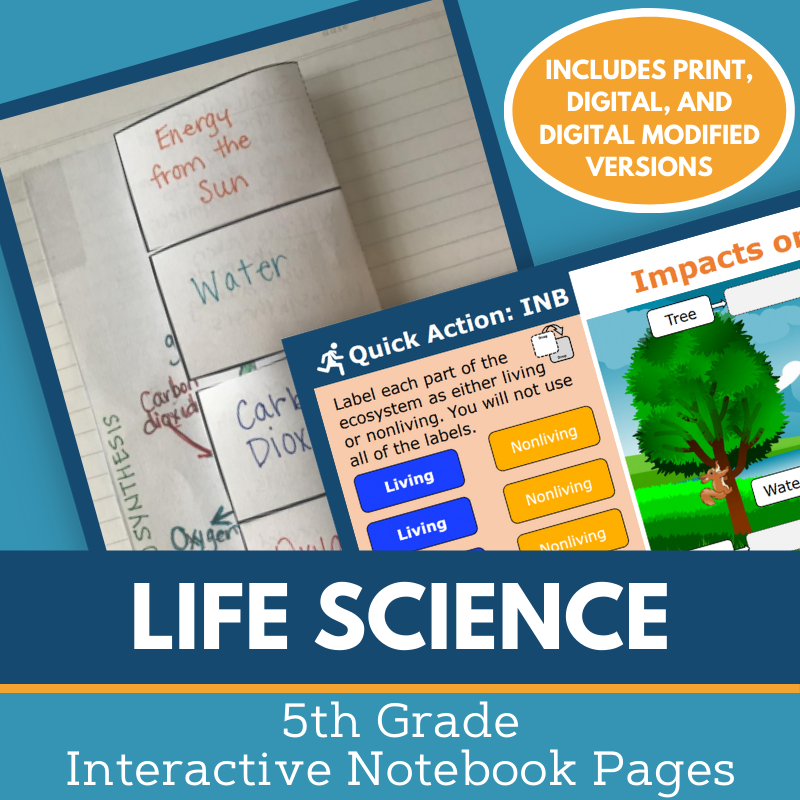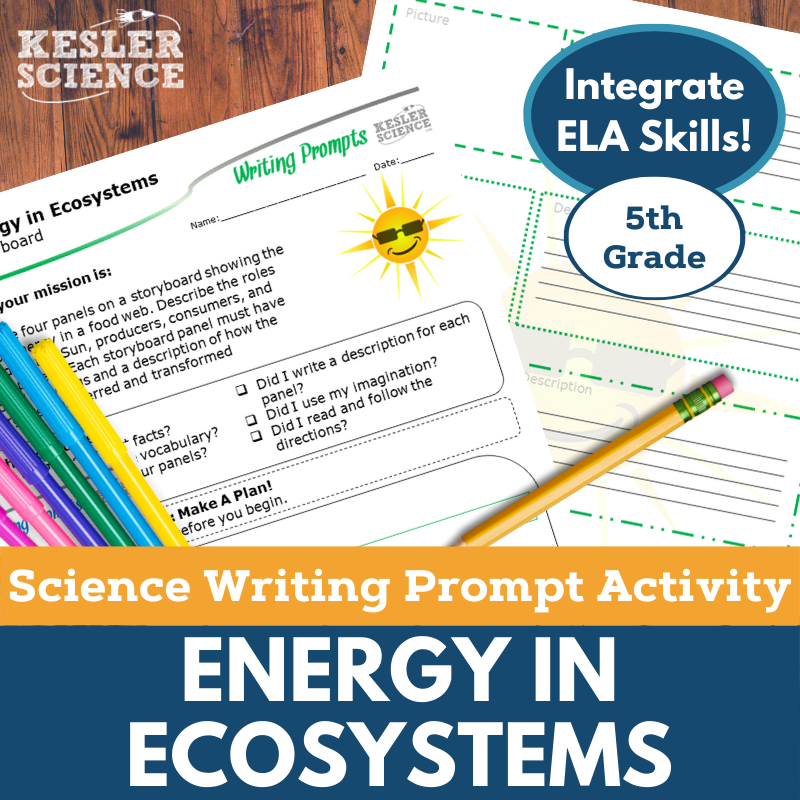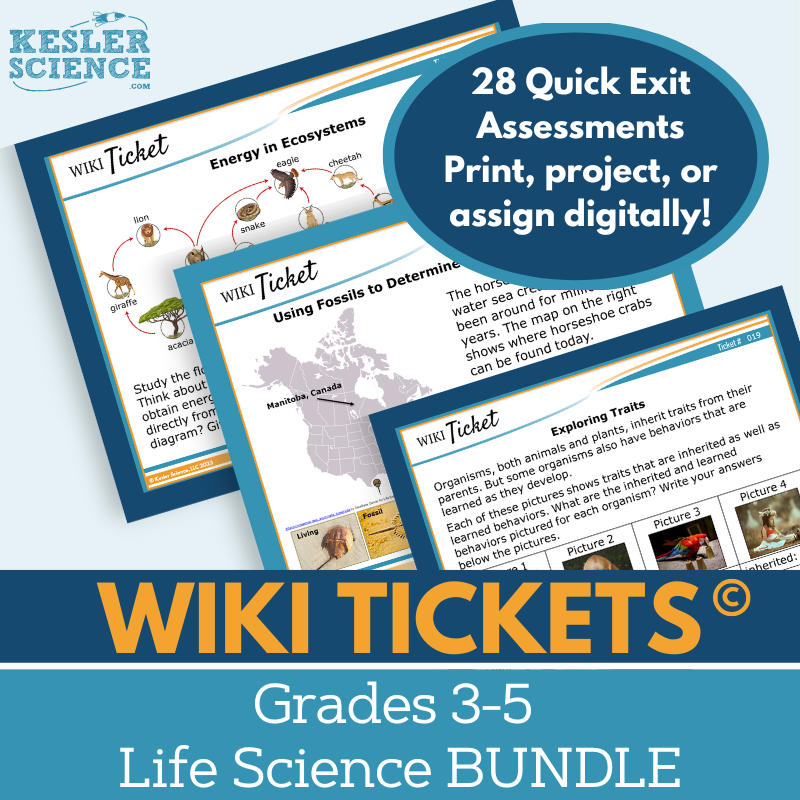Energy in Ecosystems Activities for 5th Grade Science
The Kesler Science Energy in Ecosystems resources provide comprehensive, student-centered materials to help 5th graders understand the flow of energy in ecosystems. From engaging activities to detailed teacher instructions, the resources below will give students a comprehensive understanding of producers, consumers, decomposers, and energy flow. All of the following materials are also included in the Kesler Science Membership.
The Kesler Science Energy in Ecosystems Complete 5E Lesson equips students with the tools to describe the flow of energy in a food web, highlighting the roles of the Sun, producers, consumers, and decomposers. The lesson follows the 5E model and now includes a Spanish version of the Station Lab reading passage and updated answer keys, ensuring accessibility for all students.
The lesson provides everything you need to teach the concept effectively, from engagement materials such as objective statements and class activities to differentiated station labs that foster student-led inquiry. Students will also benefit from editable PowerPoint presentations, interactive notebook templates, and formatted notes to support different learning needs.
As students deepen their understanding, they will complete a student choice science project to elaborate on the content. Evaluation includes engaging homework and assessments with both open-ended and modified questions, ensuring comprehensive learning and mastery of the concepts.
The Kesler Science Energy in Ecosystems Complete 5E Lesson equips students with the tools to describe the flow of energy in a food web, highlighting the roles of the Sun, producers, consumers, and decomposers. The lesson follows the 5E model and now includes a Spanish version of the Station Lab reading passage and updated answer keys, ensuring accessibility for all students.
The lesson provides everything you need to teach the concept effectively, from engagement materials such as objective statements and class activities to differentiated station labs that foster student-led inquiry. Students will also benefit from editable PowerPoint presentations, interactive notebook templates, and formatted notes to support different learning needs.
As students deepen their understanding, they will complete a student choice science project to elaborate on the content. Evaluation includes engaging homework and assessments with both open-ended and modified questions, ensuring comprehensive learning and mastery of the concepts.
The Kesler Science Energy in Ecosystems Station Lab offers a dynamic, student-led approach to 5th-grade science that keeps learners engaged while reducing prep time for teachers. This station lab covers the flow of energy in a food web, exploring the roles of the Sun, producers, consumers, and decomposers. With the inclusion of a Spanish version of the reading passage, this resource is accessible to all learners.
Students will rotate through eight differentiated stations, each offering activities designed to foster independent learning and discovery. Teachers guide the process, but students take charge of their learning experience. The stations include a variety of hands-on activities such as experiments, drawing, video-based learning, and research, ensuring multiple ways for students to engage with the content.
The station lab is adaptable for both in-person and remote settings. In virtual environments, students can interact with the materials through Google Slides or PowerPoint, and even submit responses digitally. Detailed instructions and a free Start-Up Guide provide teachers with everything needed to implement this station lab effectively, including support for distance learning platforms like Google Classroom and MS Teams.
The Kesler Science Energy in Ecosystems Station Lab offers a dynamic, student-led approach to 5th-grade science that keeps learners engaged while reducing prep time for teachers. This station lab covers the flow of energy in a food web, exploring the roles of the Sun, producers, consumers, and decomposers. With the inclusion of a Spanish version of the reading passage, this resource is accessible to all learners.
Students will rotate through eight differentiated stations, each offering activities designed to foster independent learning and discovery. Teachers guide the process, but students take charge of their learning experience. The stations include a variety of hands-on activities such as experiments, drawing, video-based learning, and research, ensuring multiple ways for students to engage with the content.
The station lab is adaptable for both in-person and remote settings. In virtual environments, students can interact with the materials through Google Slides or PowerPoint, and even submit responses digitally. Detailed instructions and a free Start-Up Guide provide teachers with everything needed to implement this station lab effectively, including support for distance learning platforms like Google Classroom and MS Teams.
The Kesler Science Energy in Ecosystems Student Choice Projects offer 5th graders the opportunity to select a project that matches their learning style. With six different project options plus a "design your own" choice, students can express their understanding in creative ways. Teachers can use or modify the provided rubric to assess student work, offering flexibility for peer or self-assessment.
The resource includes nine project options, teacher directions, and editable rubric pages that focus on key concepts such as vocabulary, clarity, and presentation. Differentiated options help meet the needs of diverse learners, offering remediation or challenge tasks.
Designed for ease of use, the projects require basic classroom supplies like paper, markers, and scissors, with many options also available for digital completion. Some projects may involve crafting for model-building activities.
The Kesler Science Energy in Ecosystems Student Choice Projects offer 5th graders the opportunity to select a project that matches their learning style. With six different project options plus a "design your own" choice, students can express their understanding in creative ways. Teachers can use or modify the provided rubric to assess student work, offering flexibility for peer or self-assessment.
The resource includes nine project options, teacher directions, and editable rubric pages that focus on key concepts such as vocabulary, clarity, and presentation. Differentiated options help meet the needs of diverse learners, offering remediation or challenge tasks.
Designed for ease of use, the projects require basic classroom supplies like paper, markers, and scissors, with many options also available for digital completion. Some projects may involve crafting for model-building activities.
The Kesler Science 5th Grade Life Science Interactive Notebook Bundle provides engaging, hands-on learning for key life science topics. This comprehensive resource includes both print and digital versions, making it perfect for traditional classrooms, 1:1 environments, and distance learning.
The digital interactive notebook features a unique PowerPoint format, Google Slides compatibility, reflection pages, space for notes, and a modified version for students with accommodations. The paper version includes blank and pre-filled templates, plus color photo examples for easy implementation.
Covering topics like plant growth, ecosystems, fossil evidence, and inherited traits, this bundle helps students organize their learning while giving teachers flexible, high-quality materials to enhance instruction.
The Kesler Science 5th Grade Life Science Interactive Notebook Bundle provides engaging, hands-on learning for key life science topics. This comprehensive resource includes both print and digital versions, making it perfect for traditional classrooms, 1:1 environments, and distance learning.
The digital interactive notebook features a unique PowerPoint format, Google Slides compatibility, reflection pages, space for notes, and a modified version for students with accommodations. The paper version includes blank and pre-filled templates, plus color photo examples for easy implementation.
Covering topics like plant growth, ecosystems, fossil evidence, and inherited traits, this bundle helps students organize their learning while giving teachers flexible, high-quality materials to enhance instruction.
The Kesler Science Energy in Ecosystems Writing Activity gives 5th graders an engaging way to demonstrate their understanding of producers and consumers. Using a storyboard format, students apply their science knowledge while strengthening their writing skills. Designed for both classroom and virtual learning, this low-prep resource keeps students actively involved.
With multiple formats, including projection, full-sized handouts, half-sheet versions, and an interactive digital file, this resource adapts to any teaching style. Teacher guides, rubrics, and self-check tools support assessment and student success.
Perfect for elaboration, formative assessment, or student choice projects, this writing activity enhances science instruction while reinforcing literacy skills. It’s an excellent fit for cross-curricular learning, early finishers, or differentiation needs.
The Kesler Science Energy in Ecosystems Writing Activity gives 5th graders an engaging way to demonstrate their understanding of producers and consumers. Using a storyboard format, students apply their science knowledge while strengthening their writing skills. Designed for both classroom and virtual learning, this low-prep resource keeps students actively involved.
With multiple formats, including projection, full-sized handouts, half-sheet versions, and an interactive digital file, this resource adapts to any teaching style. Teacher guides, rubrics, and self-check tools support assessment and student success.
Perfect for elaboration, formative assessment, or student choice projects, this writing activity enhances science instruction while reinforcing literacy skills. It’s an excellent fit for cross-curricular learning, early finishers, or differentiation needs.
The Kesler Science Life Science WIKI Tickets offer fun and engaging formative assessments for 3rd–5th grade students. With 28 topics aligned to NGSS and TEKS standards, these exit tickets cover essential life science concepts such as ecosystems, traits, life cycles, and energy flow.
Each WIKI Ticket comes in multiple formats, including a projectable display, three printable handout sizes, and a digital version for PowerPoint or Google Slides. This flexibility makes them perfect for quick checks of student understanding, whether in-person or virtual.
Use WIKI Tickets as exit tickets, bellringers, or anytime you need to assess student learning. Their colorful, interactive design helps keep students engaged while providing valuable insights into their progress.
The Kesler Science Life Science WIKI Tickets offer fun and engaging formative assessments for 3rd–5th grade students. With 28 topics aligned to NGSS and TEKS standards, these exit tickets cover essential life science concepts such as ecosystems, traits, life cycles, and energy flow.
Each WIKI Ticket comes in multiple formats, including a projectable display, three printable handout sizes, and a digital version for PowerPoint or Google Slides. This flexibility makes them perfect for quick checks of student understanding, whether in-person or virtual.
Use WIKI Tickets as exit tickets, bellringers, or anytime you need to assess student learning. Their colorful, interactive design helps keep students engaged while providing valuable insights into their progress.
Year-Round Resources
These year-round activities will increase your students' understanding of many middle school science topics. All of these activities are also included in the Kesler Science Membership.
Visual Data & Graphing
You're not alone if your students struggle with understanding graphs, charts, and tables. It's a skill that takes an enormous amount of practice. This resource will help students build a strong foundation in analyzing data and creating their own data visualizations.
Bell Ringers and Warm-Ups
These middle school science bell ringers are an excellent way to engage your students as soon as they walk into your classroom. This comprehensive FULL YEAR resource includes everything you need to start off each science class with an interesting warm-up activity.
Review Board Games
Each game board has been carefully designed to keep students engaged. There are 10 different action spaces on each board and dozens of question cards. All of the actions are related to science concepts and keep the students motivated throughout the game.
Each game is ready to play. Simply print out the board and the cards and let the students enjoy reviewing nine different units.
Essential Questions
Below are the essential questions associated with the lessons and activities included in this unit. This topic is only one of more than 100 middle school science topics included in the Kesler Science Membership.
-
How can we model the flow of energy in an ecosystem?
-
What are the differences between producers, consumers, and decomposers?
Kesler Science Membership
Imagine never having to search for another middle school science lesson again. The membership gives you access to ALL of the Kesler Science products in one place (Yes, including everything above).
Say goodbye to long hours of lesson prep.

